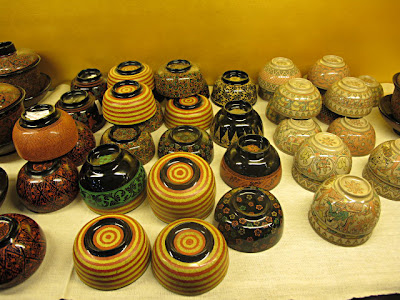The various stages of how a lacquer plate is made,
Bagan House, Bagan
Applying coats of lacquer, Bagan House, Bagan
Engraving a design, Bagan House, Bagan
Engraving a design, Bagan House, Bagan
Polishing process, Bagan House, Bagan
Lacquer wares, Bagan House, Bagan
Lacquer wares, Bagan House, Bagan
Aung San Su Kyi calendar with lacquer wares, Bagan House, Bagan
A FASCINATING TRADITION for the visitor, was the busy workshop at Bagan House. The place had been highly recommended by another traveller and it seemed like a good place to stop for some gifts. Touristy as it may have been, being shown the various stages of production by a guide, was of great interest. Inevitably one ended up in quite a large shop, where one was told you shouldn't take more then a few photos, but were that seemed to be waived once the wallet came out. The quality of the wares seemed excellent and this was such a welcome diversion from the other sights, found out in the open sun.
Burmese lacquer production makes use of natural and timeless ingredients. The base is usually made from wood, bamboo or horse hair. The lacquer itself is obtained from the sap of a tree (Melanorrhoea usitatissima) or "Thitsee" in Burmese, found in Myanmar's northern jungles.
The process is best explained in the quote below, straight out of Wikipedia:
The process is best explained in the quote below, straight out of Wikipedia:
"Lacquer vessels, boxes and trays have a coiled or woven bamboo-strip base often mixed with horsehair, and the thitsee may be mixed with ashes or sawdust to form a putty-like substance called thayo which can be sculpted. The object is coated layer upon layer with thitsee and thayo to make a smooth surface, polished and engraved with intricate designs, commonly using red, green and yellow colours on a red or black background. Shwezawa is a distinctive form in its use of gold leaf to fill in the designs on a black background.[
Palace scenes, scenes from the Jataka the tales, and the signs of the Burmese Zodiac are popular designs and some vessels may be encrusted with glass mosaic or semi-precious stones in gold relief.The objects are all handmade and the designs and engraving done free-hand. It may take three to four months to finish a small vessel but perhaps over a year for a larger piece. The finished product is a result of teamwork and not crafted by a single person."
The Bagan House official website:
The Bagan House official website:








No comments:
Post a Comment